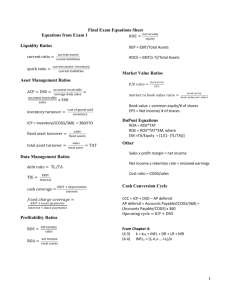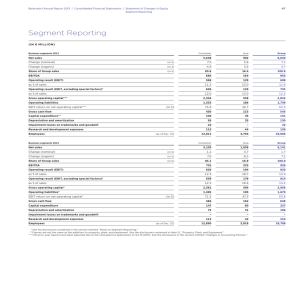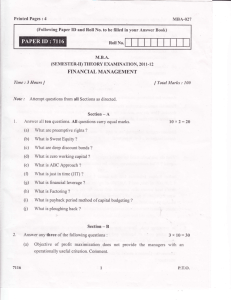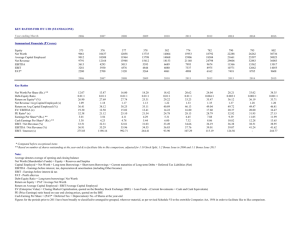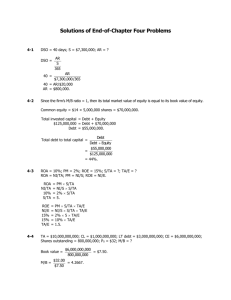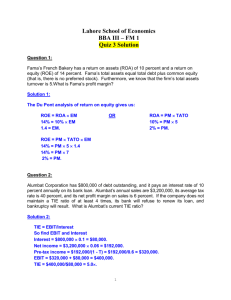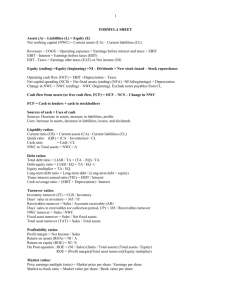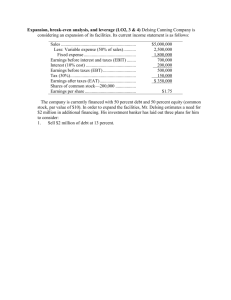Equations Final
advertisement
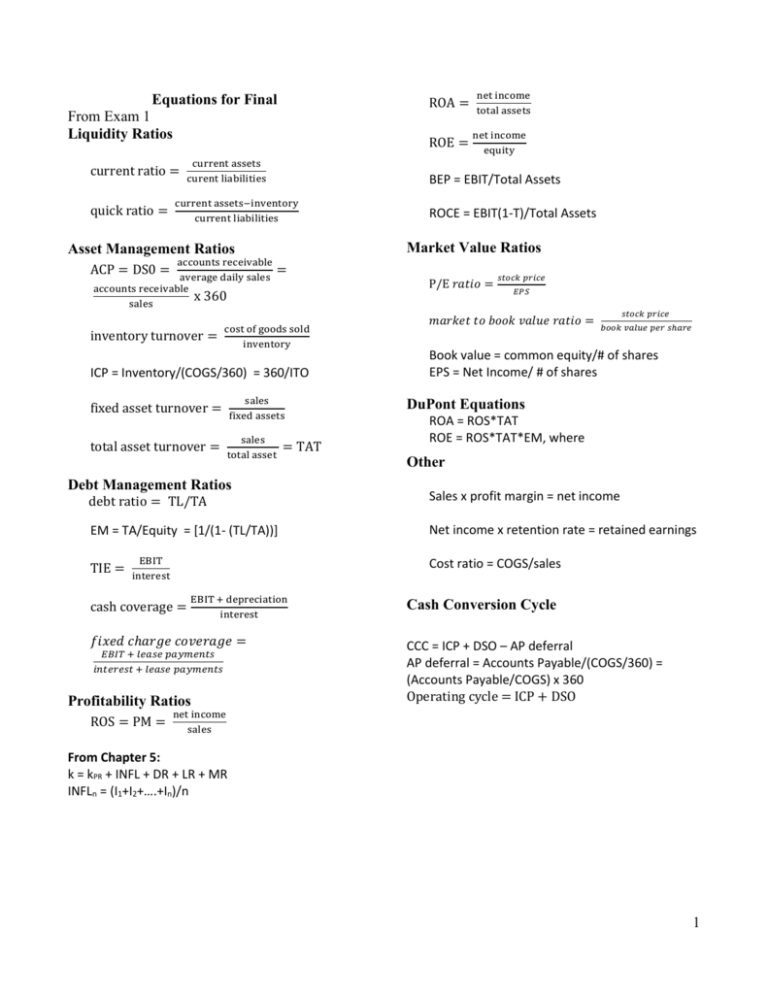
Equations for Final ROA = From Exam 1 Liquidity Ratios ROE = current ratio = quick ratio = current assets curent liabilities ROCE = EBIT(1-T)/Total Assets Market Value Ratios Asset Management Ratios inventory turnover = net income equity BEP = EBIT/Total Assets current assets−inventory current liabilities accounts receivable ACP = DS0 = average daily sales accounts receivable x 360 sales net income total assets = P/E 𝑟𝑎𝑡𝑖𝑜 = cost of goods sold inventory ICP = Inventory/(COGS/360) = 360/ITO fixed asset turnover = sales fixed assets total asset turnover = sales total asset = TAT Debt Management Ratios 𝑠𝑡𝑜𝑐𝑘 𝑝𝑟𝑖𝑐𝑒 𝐸𝑃𝑆 𝑚𝑎𝑟𝑘𝑒𝑡 𝑡𝑜 𝑏𝑜𝑜𝑘 𝑣𝑎𝑙𝑢𝑒 𝑟𝑎𝑡𝑖𝑜 = 𝑠𝑡𝑜𝑐𝑘 𝑝𝑟𝑖𝑐𝑒 𝑏𝑜𝑜𝑘 𝑣𝑎𝑙𝑢𝑒 𝑝𝑒𝑟 𝑠ℎ𝑎𝑟𝑒 Book value = common equity/# of shares EPS = Net Income/ # of shares DuPont Equations ROA = ROS*TAT ROE = ROS*TAT*EM, where Other debt ratio = TL/TA Sales x profit margin = net income EM = TA/Equity = [1/(1- (TL/TA))] Net income x retention rate = retained earnings TIE = EBIT interest Cost ratio = COGS/sales cash coverage = EBIT + depreciation interest 𝑓𝑖𝑥𝑒𝑑 𝑐ℎ𝑎𝑟𝑔𝑒 𝑐𝑜𝑣𝑒𝑟𝑎𝑔𝑒 = 𝐸𝐵𝐼𝑇 + 𝑙𝑒𝑎𝑠𝑒 𝑝𝑎𝑦𝑚𝑒𝑛𝑡𝑠 𝑖𝑛𝑡𝑒𝑟𝑒𝑠𝑡 + 𝑙𝑒𝑎𝑠𝑒 𝑝𝑎𝑦𝑚𝑒𝑛𝑡𝑠 Profitability Ratios ROS = PM = Cash Conversion Cycle CCC = ICP + DSO – AP deferral AP deferral = Accounts Payable/(COGS/360) = (Accounts Payable/COGS) x 360 Operating cycle = ICP + DSO net income sales From Chapter 5: k = kPR + INFL + DR + LR + MR INFLn = (I1+I2+….+In)/n 1 Two simplified or “textbook” income statement formats used this semester. sales -COGS Gross margin -Expenses EBIT - Int. EBT - Tax NI -DIV RE sales -VC Gross margin -FC EBIT - Int. EBT - Tax NI -DIV RE is dividends. RE is the contribution to retained earnings this accounting period. EBIT is operating income. Int. is interest expense not the interest rate. Taxes are income taxes and DIV Simplified Balance Sheet as used this semester Assets Cash Accounts receivable Inventory Current Assets 1000 3000 2000 6000 Fixed assets: Gross PP&E Accumulated dep. Net Fixed Assets $4000 (1000) $3000 Total Assets 9000 Liabilities and Owner’s Equity Accounts payable 1000 Accruals 500 Notes payable 1000 Current Liabilities 2500 Long term debt Total Liabilities 5000 7500 Stockholder Equity 1500 Total Liab. & Equity 9000 Current Assets= gross working capital Net Working Capital = CA-CL PP&E is property plant and equipment. Equity is usually divided into at least Stock and accumulated Retained Earnings. Stock is sometimes divided into Par Value and Paid in Excess. Sometimes equity is called net worth. Paid in Excess is also called surplus. From Exam 2 8. Contribution margin = CM = (P-V)/P 1. BEP = EBIT/Total Assets 9. Operating breakeven quantity: 2. ROCE = EBIT 1 - tax rate debt + equity ROCE = BEP (1- tax rate) 3. After-tax cost of debt = Kd(1- tax rate) 4. ROE = NI/Equity 5. EPS = NI/ #shares 6. NI = [EBIT – interest exp.](1- tax rate) 7. Contribution = P – V QB/E = FC / (P – V) 10. Financial breakeven quantity: QBE= (FC+I)/(P - V) 11. SB/E = QB/E(P) SB/E = FC / CM 12. 𝐷𝑂𝐿 = 𝑆−𝑉𝐶 𝑆−𝑉𝐶−𝐹𝑐 = 𝐺𝑟𝑜𝑠𝑠 𝑃𝑟𝑜𝑓𝑖𝑡 𝐸𝐵𝐼𝑇 13. %ΔEBIT = DOL x %ΔSales 2 𝑛 EBIT 14. DFL = EBIT - Interest 2 𝜎 = ∑ 𝑝𝑖 (𝑘𝑖 − 𝑘̂ ) 2 𝑖=1 24. Standard deviation: 𝜎 = √𝜎 2 15. %ΔEPS = DFL x %ΔEBIT 16. DTL 𝜎 25. CV = ̂ 𝑘 Sales VC DOLxDFL EBIT Interest 26. Portfolio beta: 𝑛 17. %ΔEPS = DTL x %ΔSales 𝛽𝑝 = ∑ 𝛽𝑖 𝑤𝑖 𝑖=1 18. PV of a perpetual annuity: PV = PMT 27. Portfolio expected return: 𝑛 K 𝑘̂𝑝 = ∑ 𝑘̂𝑖 𝑤𝑖 19. Constant growth model: P0 D1 D (1 g) 0 Ks g Ks g 𝑖=1 28. Effective Annual interest rate: n i EAR 1 1 n In general, if the constant growth model is applied after time zero then: PN 1 DN Ks g 29. current yield on a bond = (annual coupon interest)/ (current bond price) 20. SML: Ks = KRF + (KM – KRF)s 30. YTM = current yield + capital gains yield (If you know the YTM and the current yield on a bond, you can subtract to get the expected capital gains.) 31. The required return on a stock is equal to the dividend yield plus expected capital gains yield. 32. capital gains yield = (Pt - Pt-1)/Pt-1 33. Dividend yield = D1/P0 21. MRP = KM – KRF n 22. Mean: k̂ p i k i i 1 23. Variance: Chapter 13 Equations: n 1. WACC wi sourcei ; (weights, w, and cost of source) i 1 2. Cost of debt: Kd × (1 - tax rate) 3. Cost of preferred stock: K PF Dp (1 f )PP or = kp / (1 - f) 4. Cost of retained earnings from SML: Kx = KRF + bX (Km - KRF) 5. Cost of retained earnings from constant growth model: 6. Cost of new stock: Ke D 0 (1 g) g (1 f )P0 Ke D 0 (1 g) g P0 3 “Equation” Sheet for AGEC 424 Exam 3 Net Salvage Value (NSV) Calculation Adjusted Basis: Tax on SV: NSV: Initial Basis -Accumulated dep. Adjusted Basis Selling Price -Adjusted Basis Taxable gain (loss) x tax rate Tax (tax “credit” if neg.) Selling price -Tax on SV NSV Replacement Investmenta (we will do the third column) Buy a new machine Keep your old machine Replacement = Buy new minus keep oldb a. Initial outlay items -Cost of new machine -/+ NWC - Current NSV old machine -Cost of new machine - /+NWC + Current NSV old machine b. Operating cash flow items of note Depreciation new machine Depreciation old machine c. Terminal Cash Flow items + NSV new machine +/-NWC offset + ending NSV old machine Change in depreciation is used in the modified income statement to get operating cash flow + NSV new machine - ending NSV old machine +/-NWC offset a In AGEC 424 we always do replacement problems where the life is the same for the new and for the old. If the life is different one needs to take the net present values of “new machine” and “keep old” separately and then compute the equivalent annual annuity before comparing. b There are three items in bold. These are the three differences between a new investment problem and a replacement investment problem. 1. SML: ks = kRF + s (kM – kRF) n 2. Mean or expected value: k̂ p i k i i 1 3. ∆NWC = ∆CA - ∆CL = ∆Inv. + ∆ AR - ∆AP - ∆Accruals [we omit cash and notes payable from working capital for problems in this section of the course] 4
